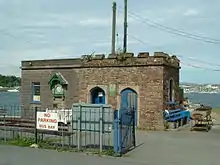Cremyll
Cremyll (pronounced /ˈkrɛməl/) is a small coastal village in south-east Cornwall, England, United Kingdom. Cremyll is on the Rame Peninsula facing Plymouth Sound. It is situated close to Plymouth, about 9 miles (14 km) by road or 1⁄2 mile (0.80 km) by boat (or passenger ferry) from Plymouth.[1] It is in the civil parish of Maker-with-Rame.

History
There has been a ferry at Cremyll since the 11th century and it was a link in the main southern route into Cornwall until the 1830s. There was a larger community here called West Stonehouse (compare with East Stonehouse) until it was burnt by the French in 1350. In medieval times the ferry was part of the manor of Stone-House, held by the Valletorts.[2]
The Cornish side of Plymouth Sound was not always Cornish. It was incorporated into Anglo-Saxon territory in 705 ADanachronistic in order to secure both banks of the estuary against Viking raids. An area of the Rame Peninsula, (up to Kingsand) remained as part of Devon until 1844, when it was made part of Cornwall.[3] Today, however, Mount Edgcumbe and the waterfront settlement of Cremyll are emphatically Cornish. They stand on the most easterly extension of the Rame Peninsula known with ironic pride by local people as the "Forgotten Corner."
Culture and community
Today the Cremyll Ferry carries foot passengers and cyclists from Cremyll to Plymouth. Cremyll is on the South West Coast Path which is the longest of the waymarked long-distance footpaths in England.
In the village is The Edgcumbe Arms, which dates back to the 18th century; it was destroyed by fire and rebuilt in 1995.[4][5]

Cremyll's former schoolroom and chapel was built at the expense of the William Edgcumbe in 1867. It is now a private residence, the Old School Rooms.[6][7]
Landmarks
The main entrance to Mount Edgcumbe House is in Cremyll. Mount Edgcumbe House is a stately home and a Grade II listed building, whilst the gardens are listed as Grade I in the Register of Parks and Gardens of Special Historic Interest in England. Cremyll has a pay and display car park operated by Cornwall Council with about 50 spaces, mainly there for visitors to Mount Edgcumbe Country Park.
References
- Ordnance Survey: Landranger map sheet 201 Plymouth & Launceston ISBN 978-0-319-23146-3
- Henderson, C. (1935) "Ferries in Cornwall", in Essays in Cornish History, edited by A. L. Rowse and M. I. Henderson. Oxford: Clarendon Press; pp. 163-67
- "Walks: The Cornish shores of Plymouth Sound". theaa.com. the aa. Retrieved 29 September 2015.
- "Edgcumbe Arms - Picture of The Edgcumbe Arms, Cremyll". www.tripadvisor.co.uk. TripAdvisor. Retrieved 30 September 2015.
- "The Edgecumbe Arms". www.edgcumbearms.co.uk. Edgcumbe Arms. Retrieved 30 September 2015.
- "Reopening of Cremyll School Chapel". The Western Morning News. 2 April 1884. Retrieved 10 January 2021 – via British Newspaper Archive.
- Tait, Derek (2010). Rame Peninsula Through Time. Amberley Publishing Limited – via Google Books.
External links
![]() Media related to Cremyll at Wikimedia Commons
Media related to Cremyll at Wikimedia Commons
